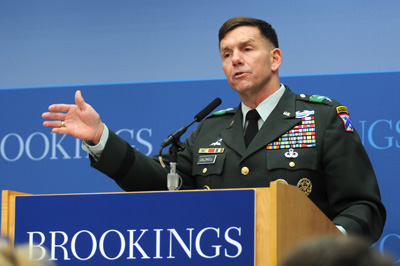By C. Todd Lopez
WASHINGTON (March 30, 2009) -- Re-establishing and maintaining a safe and secure environment following conflict is something the Army has done since its beginnings, but something it acknowledges it can no longer do alone.
"I think you'll see in the manual we continually talk about the need for a comprehensive approach," said Lt. Gen. William B. Caldwell IV, commander, Combined Arms Center, Fort Leavenworth, Kan., during a March 27 panel discussion at the Brookings Institution in Washington, D.C.

The discussion involved Army Field Manual 3-07, "Stability Operations," which was released in October. The panel included Michèle Flournoy, undersecretary of defense for policy; Carlos Pascual, vice president and director, foreign policy, the Brookings Institution; and Janine Davidson, assistant professor, George Mason University, nonresident fellow, the Brookings Institution.
"The military has an incredible destructive capability and that is the core mission of what we exist for and we should not lose that," Caldwell said. "Whenever we can increase the civilian capacity to work in a comprehensive manner with us -- that is what we would prefer to do."
With the February 2008 edition of the Army operations manual, FM 3-0, the Army elevated the status of "stability operations," putting it on par with the two traditional core Army missions: offensive and defensive operations. In October, the Army published the latest edition of FM 3-07, the document that defines stability operations.
Caldwell said the Army realizes it must work in conjunction with civilian agencies of the U.S. government in addition to non-governmental organizations to accomplish the goals set forth in FM 3-07.
"The military is really not interested in taking on any of the civilian functions and capabilities, but rather augment them as required so they can be much more effective and efficient in what they are trying to achieve," Caldwell said. "I think you would find most of us wanting to see an increase in civilian capability and capacity so they can in fact be in greater numbers out there so that we can operate and work in a comprehensive manner. Because that is what it is going to take -- again, the military is necessary, but it is not sufficient."
The skills needed to conduct stability operations, "soft power," are those not commonly found in the military, Caldwell told an audience of servicemembers, academics, and reporters. Instead, he said, the military must work in partnership with non-military organizations to accomplish stability -- FM 3-07 spells out those relationships.
"This manual - this stability operations doctrine - is even more unique, focusing on skills and capabilities not typically resident in our military forces," he said. "These soft power skills - rebuilding and reforming the institutions of government, revitalizing fragile economies, restoring social well-being ... are drawn from the contributions of a number of different sources: the other departments and agencies of our government, the development community, the humanitarian community, our allies and friends, even the private sector."
In the future, Caldwell said, it will be important for the Army and the military to develop partnerships with non-military agencies to ensure U.S. national government policies to create peace can be attained.
"We need to learn to train as we operate," he said. "We operate in a comprehensive manner and we have for many years. We have always done it and yet for some reason we tend to neglect that and forget it after the fact. We can't do it this time. The intent of this manual is to codify in Army doctrine how critically important that is.
"In the years ahead -- as we look to 2015, 2025 -- when we see the threats and the challenges that will be out there, they will only be able to be dealt with if it is done in a comprehensive manner."